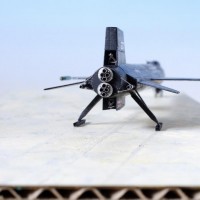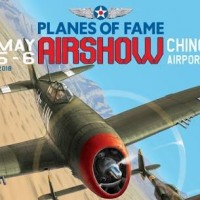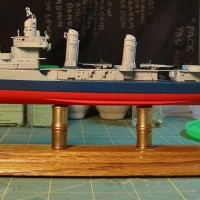US Navy Spitfire on D-Day: Eduard 1/48 Spitfire Mk. Vb
This build starts with a story that I read in the British magazine "Flypast". I had never heard this story, and it was so cool that I couldn't resist building a model to represent the Spitfires in the story. So, first is the story:
During WW2, the Navy used catapult-launched Vought OS2U Kingfishers and Curtiss SOC Seagulls as shot spotters for the battleships and cruisers. They would observe where the shells from the ships fell and make corrections, thereby increasing the accuracy of the fire. During the invasion of Sicily, several Navy spotters became easy targets for Axis fighters. When the Navy began planning for their naval gunfire support during the D-Day landings, they decided that an alternative aircraft might be used that could fulfill their function as an artillery spotter and give their pilots a better chance if they were intercepted by Nazi fighters over the beach. This was also a popular decision among the spotter pilots who really liked the idea of flying a plane that had a chance against a 109 or 190.
The Navy secured several Spitfire Mk.Vb aircraft from the RAF. These planes were not considered frontline fighters anymore, but they would provide their pilots a better chance than in a Kingfisher or Seagull. Spotter pilots from the battleships Arkansas, Texas, and Nevada, as well as cruisers Augusta, Tuscaloosa, and Quincy. They spent several months training with American Army pilots from the 67th Reconnaissance Squadron who were flying the PR Spitfire. The newly trained pilots met on the 1st of June to establish VOS-7 (VCS-7), or Observation Squadron 7. It is possible that VOS-7 was the only US Navy squadron to fly Spitfires during WW2. These planes and pilots became part of an air spotting pool operated by the 34th Reconnaissance Wing of the RAF 2nd Tactical Air Force.
These Naval Aviators began flying missions on 6 June. They would eventually fly about 200 sorties, with 94 of these sorties flown in the first 3 days. These missions were planned to be flown at 6000 feet, but many were flown at 1500 feet or less due to weather. The planes always flew in pairs, one to act as artillery spotters and one to watch for enemy aircraft. The squadron's senior aviator was killed on the first day when his plane was hit by flak, which was also responsible for most of the 8 aircraft lost to combat damage. The pilots of all 8 aircraft survived, as did the pilot of a ninth plane that was lost in a non-combat crash. On the 7th of June, Lt. D.W. Barraclought managed to shoot down an ME-109G. Four squadron pilots, including Barraclought, survived encounters with Bf-109s and Fw-190s. The squadron was disbanded when the Allies captured the town of Cherbourg and naval gunfire support was no longer needed. It is believed that this may be the shortest lifespan for a naval squadron in history. During its 3 weeks of existence, squadron pilots were awarded 9 Distinguished Flying Crosses and 11 Air Medals.
With such a great story, I couldn't resist building one of these planes. I had a 1/32 Spitfire Mk. Vb in my stash, and I planned to cobble the required markings together using the decals I had on hand. Shortly after I posted my idea in the Work in Progress Aircraft Group, Tom (@tcinla) let me know that Eduard was about to release a Weekend Kit with markings for the exact plane I wanted to build. Sure enough, a week later the kit popped up online and it was at my door a week after that. I also ordered the Eduard canopy masks, Eduard PE, as well as a Quinta set for the interior.
I had never built an Eduard kit before, but you all know there reputation. I am embarrassed to say that I had several problems with this kit, all of my own making. In the end it all came together. I painted the plane using the "new-formula" AK Real Colors, which are very nice. Once the decals were in place and sealed, I painted the invasion stripes. These stripes were actually painted in a hurry, using large brushes, brooms, and mops. I wanted to replicate this, but when I studied the photos of the planes I discovered that they were actually neatly painted. In one picture, I noticed that the black stripe was painted slightly into the fuselage roundel, so I replicated that. I also noted in the pictures that the white stripe next to the fuselage on both sides was covered in oily/dirty boot prints, so I wanted to replicate that also. All of the weathering was done using artist oils and Turpenoid. This was a fun project and it actually came out pretty well considering all of my efforts to mess it up. Thanks to all of those who visited the In Progress thread with ideas and encouragement. Cheers everyone.




















That turned out great, George. Spitfire oddities are always fun.
Thanks, John (@j-healy). I have only done one other Spitfire, but I think there may be some more in the future.
You're right! Such a great story! Well done on the Spitfire!
Thanks, Juan (@jebenite1). It turned out to be a fun build, even if I did my best to mess it up.
Well done bringing a story to life!
Thanks, John (@jsummerford). The great story is why I decided to build this plane.
Excellent result, George! As always, a pure pleasure to follow your thread. This Spitfire looks fantastic!
Well done!
Thanks for following along on the build, Spiros (@fiveten).
Superb result on this odd Spitfire, George @gblair
Especially the invasion stripes and the footprints on them came out perfectly.
Definitely an interesting thread and very learningful.
Thanks for sticking with this build, John (@johnb), especially since you were on a cool vacation.
@gblair, Vienna and Budapest, including the F1 race, was a cool holiday indeed, but not in terms of temperature
Beautiful work and a great result, George. It was fun watching
Thanks for letting me know this kit was coming out, Tom (@tcinla). Next time I will read your build article before I get into trouble.
Great story George!
USN Spitfires - so cool!
Lovely Build and weathering - I have this kit now - so will have to start building!
Great work!
Thanks, David (@davem). You will really enjoy this kit. Lots of options on this kit, so be sure to follow the instructions carefully, especially if you are adding aftermarket parts.
Awesome Work George! You've really captured the look
Thanks for the kind comments, Ian (@ianfoulk96).
Plain as black and white - great post and a great build, George.
Kit looks really nice, and fantastic work getting it done with great looking weathering and usage.
Always a good thing when you read a bit of not so popular history and get motivated and then find a kit to support your build,
Awesome photos, too.
Thanks, George (@georgeswork). I read a lot, and it seems like many of my builds are inspired by something I have read.
Congrats on your build, George @gblair. Well researched and terrific results on your Vb. I hope you tackle another Eduard kit down the road. What’s next?
The Navy Spitfire came out great George (@gblair). I can just imagine the the stories these guys were able to tell when they continued their service in the Navy. "When I flew at Normandy..."
These Spitfire kits are supposed to be real dandies and I have still to find out. From what you've said, I still believe that to be true. I have three waiting to be built.
It was fun to follow along with your build. You are quite prolific considering all the other things I know you have to do. Bravo on another successful build.
Hi Eric (@eb801). Thanks for following along, and bringing your encouragement and ideas to the build. I have several Eduard kits in the stash, I had just never built one till now. I think the build queue starts with finishing my 1/350 APD conversion, a 1/12 Tamiya motorcycle, a WW1 armored car, and a 1/48 conversion of an F-111 into the Navy version. A company named Cat4 makes 4 conversion sets for the F-111B that make all the necessary changes for the Navy version. They also make a comprehensive set of decals to build just about any of the Navy versions. My wife got me all 4 sets and the decals for Father's Day.
Thanks for following along on the build, Carl (@clipper). You sound like me. I have several Eduard kits that I have been saving for when I wanted to build a "nice" kit. This was my first Eduard kit, and all the trouble I had was entirely my own making. You will enjoy building one a lot. I plan to finish my APD before I tear into a plane.
George @gblair and Carl @clipper: Eduard's Spits are not the only game in town. Don't pass up any of the new tool Airfix Spits either. If you are a fan of the Griffon powered Mks, consider Airfix's FR Mk.XIV. It's a lot easier to build, seriously excellent and a real beauty of a plane. It would look great parked next to your Vb.
I have a Spitfire Mk 1 from Airfix built. It was a bit of a bear from a fit standpoint, but in general I like Airfix kits. I have considered getting that Griffon powered Spitfire. It is a real beauty.
@gblair - Great article and great build George. I love the weathering, it's incredibly realistic.
Thanks, Eric (@eb801) and Carl (@clipper). I really like the new Airfix releases and I got a couple of the new Airfix Spitfires to build "someday". I also have a couple of the Tamiya kits, which are also nice.
Thanks, Brian (@brithebuilder). I really like weathering with artist oils. I want to add a couple of figures to the WW1 armored car I have coming up, but they will be a long way from how well yours look.
Dear George @gblair, this is truly a beautiful build! I like the weathering very much.I have another Vb in the stash and looking at your pics makes me want to start it right away.
Thanks for the kind words, Felix (@fxrob). This was my first Eduard kit, so it was a real experience. If you haven't used artist oils to do your weathering, you might give them a try. I use almost nothing else now, and really enjoy the whole process since I stopped using all high priced stuff AK, Mig, Vallejo, etc. I will be watching for your Spit!
George (@gblair),
The more I do this hobby, the more I think about the history and people who inspire the subject matter that gets modeled. Your being a pilot and teacher and posting your journey in making not just a plastic toy but, making a representation of the Naval pilots who flew for the greater good. A great blog, entertaining, teaching a person how to fish and provide a teachable moment of the history of WWII in your own way. Two thumbs up.
Thanks, Stephen (@stephen-w-towle). I appreciate your comments. Having been an Air Force pilot, then a history instructor in both high school and college, the historic aspect of the models has always intrigued me. Thanks for following along on the build.
The USN flying Spits sporting Brit Roundels - who knew?! Great story and project, and a wonderful result! You really captured a nice, worn look.
Thanks, Greg (@gkittinger). A lot of my builds start with finding a cool story.
This is an excellent looking Spitfire, George. Great work painting it and weathering it too.
Thanks, Jay (@ssgt). It was a fun kit to build.